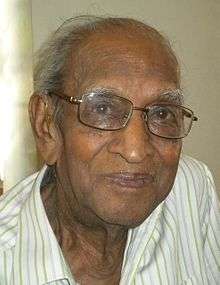Satish Chandra
| Satish Chandra | |
|---|---|
 Chandra in 2016 | |
| Born |
20 November 1922 Meerut, Uttar Pradesh |
| Died | 13 October 2017 (aged 94) |
| Nationality | Indian |
| Alma mater | Allahabad University |
| Occupation | Historian |
| Known for | Authoring books about medieval Indian history |
Satish Chandra (20 November 1922 – 13 October 2017) was an Indian historian whose main area of specialisation was medieval Indian history.[1]
Personal life
Satish Chandra was born in Meerut, Uttar Pradesh (then the United Provinces), on 20 November 1922 to Sir Sita Ram, India's first High Commissioner to Pakistan,[2] and his wife, Basudevi. He attended Allahabad University where he earned his B.A. (1942), M.A. (1944), and D.Phil (1948) under R.P. Tripathi.[3][4] His doctoral thesis was on the Parties and Politics in 18th century India.[2]
Chandra was married to Savitri and had three sons.[5] He died on 13 October 2017.[6]
Career
Chandra was Professor of History at Jawaharlal Nehru University (JNU) in New Delhi.[7] He earlier taught at Allahabad University, Aligarh Muslim University, Delhi University, and Rajasthan University and was the Smuts' Visiting Professor at Cambridge in 1971. Chandra was the secretary and president of the Indian History Congress in 1973.[8] Along with S. Gopal, Bipan Chandra, and Romila Thapar, he also founded the Centre for Historical Studies at the School of Social Sciences in JNU.[9] He was also its chairperson for a few years.
Chandra has been described as one of India's leading scholars of the Mughal period and one of India's most influential historians.[10] His book, Medieval India, has been widely used as a textbook in schools and colleges around India.[10][7]
Through the 1970s, Satish Chandra was the vice chairman and chairman of the University Grants Commission of India.[7] Among his various other appointments, he served in the council of the United Nations University, Tokyo between 1980 and 1986. He was also an associated director of research at the Maison des Sciences de l'Homme as well as an executive board member at the International Congress of Historical Sciences, both in Paris.[8] In 1988, he was asked by Union Public Service Commission to head a committee to review the system of appointments to the higher civil services.[11]
Ideology
Satish Chandra belonged to the group of historians, along with Romila Thapar, R. S. Sharma, Bipan Chandra and Arjun Dev, who are sometimes referred to as "left-leaning" or "influenced by Marxist approach to history."[12] In 2004 his textbook was reintroduced in the national curriculum after a hiatus of six years.[13]
Selected books
- Books authored
- The 18th Century in India: Its Economy and the Role of the Marathas, the Jats, the Sikhs, and the Afghans. Calcutta: Centre for Studies in Social Sciences. 1986. OCLC 17970100.
- Essays in Medieval Indian Economic History. New Delhi: Munshiram Manoharlal Publishers. 1987. ISBN 978-8121500852.
- Mughal Religious Policies, the Rajputs & the Deccan. New Delhi: Vikas Pub. House. 1993. ISBN 978-0-7069-6385-4.
- Historiography, religion, and state in medieval India. New Delhi: Har-Anand Publications. 1996. ISBN 978-8124100356.
- Medieval India: From Sultanat to the Mughals. New Delhi: Har-Anand Publications. 1997. ISBN 978-8124105221.
- Parties and Politics at the Mughal Court, 1707-1740. Oxford University Press. 2002. ISBN 978-0-19-565444-8.
- Essays on Medieval Indian History. New Delhi: Oxford University Press. 2003. ISBN 978-0-19-566336-5.
- State, Pluralism, and the Indian Historical Tradition. Oxford University Press. 2008. ISBN 978-0-19-569621-9.
- State, Society, and Culture in Indian History. Oxford University Press. 2012. ISBN 978-0-19-807739-8.
- Books edited
References
- ↑ T.K. Rajalakshmi (28 April – 11 May 2001). "Targeting history". Frontline. Archived from the original on 4 May 2008. Retrieved 21 March 2009.
- 1 2 Batabyal, Rakesh. Prof Satish Chandra: Historian and academic ambassador. National Herald.
- ↑ Who's who in India. Guide Publications. 1986. p. 81.
- ↑ Sagar, H. L. (1986). Who's Who, Indian Personages. Crystal Ship Pub. p. 60.
- ↑ India Who's who. INFA Publications. 1990. p. 470.
- ↑ "Historian Satish Chandra passes away". The Times of India. Retrieved 13 October 2017.
- 1 2 3 Chandra, Satish (13 February 2002). "Guru Tegh Bahadur's Martyrdom". Outlook. Retrieved 25 September 2014.
- 1 2 Chandra, Satish (2005). Medieval India: From Sultanat to the Mughals Part - II. Back-flap: Har-Anand Publications. ISBN 9788124110669.
- ↑ "Historian Bipan Chandra passes away". The Hindu. 30 August 2014. Retrieved 25 September 2014.
- 1 2 Avril, Powell (October 1995). "Reviews: Satish Chandra: Mughal religious policies: the Rajputs and the Deccan". Bulletin of the School of Oriental and African Studies. School of Oriental and African Studies, University of London. 58 (3): 582. doi:10.1017/S0041977X0001332X. Retrieved 6 March 2016.
- ↑ Arora, Ramesh; Goyal, Rajni (1996). Indian Public Administration (Revised Second ed.). New Delhi: Wishwa Prakashan. p. 363. ISBN 81-7328-068-1.
- ↑ Guichard, Sylvie (2010), The Construction of History and Nationalism in India, Routledge, p. 87, ISBN 1136949313
- ↑ D.R. Chaudhry (28 April 2002). "Critiques galore!". The Tribune. Chandigarh. Retrieved 6 March 2009.